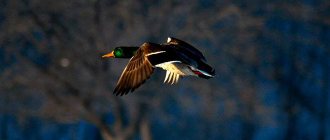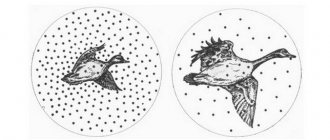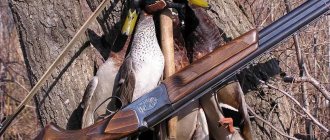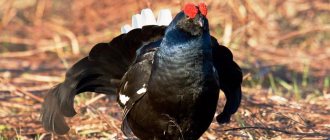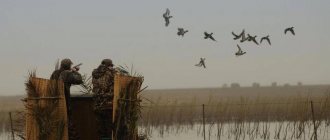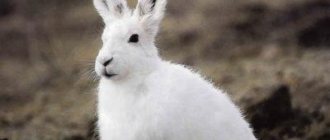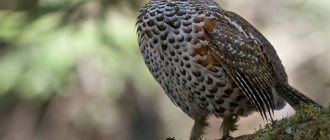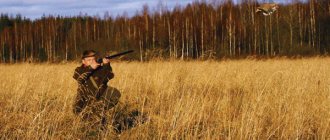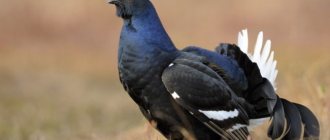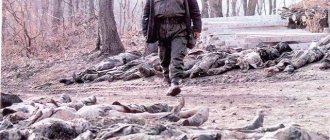- October 21, 2018
- Miscellaneous
- Michael
Probably every hunter has heard about autumn hunting for ducks with stuffed animals. However, not everyone knows the subtleties that allow them to be used correctly to become the owner of serious trophies. One of the most important components is the correct placement of stuffed ducks in the fall. It is important to remember this, as well as to know certain subtleties and nuances in order to lure the bird and not scare it away, as inexperienced hunters often do.
Which stuffed animals to choose?
Quite often, you can hear from young hunters the version that, in fact, stuffed animals do not bring any benefit to the hunt. Moreover, there is only one harm from them - all you have to do is go to a suitable lake with stuffed animals, and not a single duck will land on it. At the same time, if you do without tricks, you can still get a few trophies. What's the matter?
In fact, everything is very simple - many beginners do not know how to properly arrange stuffed ducks. Having purchased a couple of products in the store, they randomly scatter them around the pond and, having settled in a convenient place, wait for the duck to start landing on their heads. Of course, with this approach, stuffed animals will only scare away the birds. So, this issue should be taken seriously. And first of all, you need to find out which stuffed animals are best to purchase.
First of all, you should pay attention to their sizes. It is advisable to choose larger stuffed animals, even if their dimensions seem implausibly large. Experienced hunters often note that it is decoys, which are 1.5-2 times larger in size than real birds, that best attract ducks. On the one hand, they are easier to notice. On the other hand, the presence of larger (and therefore adult, experienced) relatives instills greater confidence in the birds.
The next stage is poses. If possible, try to purchase stuffed animals that copy ducks at different moments of the action: swimming with folded wings, taking off, stretching their necks, and others. A large number of standard ducks may well scare away their relatives, instilling in them unnecessary suspicion.
Hunting for drakes with stuffed animals
Despite all the attractiveness of hunting with a decoy duck, most hunters do not have the opportunity to raise and keep a bird. Therefore, replacing the decoy duck with a stuffed animal is becoming increasingly popular.
.
Today, hunting stores have a sufficient selection of duck stuffed animals for spring
duck hunting, both domestic and imported.
- What stuffed animals to use for spring hunting
The most popular rubber decoys for spring hunting
– they are easy to transport, balance well on the water, and more closely resemble a real duck than others. Among their disadvantages is that the color is not always correct, which is more difficult to convey on rubber than, say, on plastic.
Plastic decoys for duck hunting in spring
They are also produced, but they are noticeably inferior to rubber ones - they do not wrinkle during transportation, and therefore take up a lot of space. In addition, they are noticeably lighter than rubber decoys, and therefore, with already small ripples, plastic decoys do not move entirely naturally. To solve this problem, balancers are installed at the bottom of the product, but this does not always help.
They make wooden stuffed animals for spring hunting.
, and often at home. They are less convenient - they are heavy and bulky, but in appearance, if done well, they are in no way inferior to rubber and plastic ones. And for some it is also a way to save money.
Special craftsmen make stuffed animals for hunting drakes in the spring from polyurethane foam
– the effigy is formed in a plaster mold. One can of polyurethane foam produces 5-6 mallards - cheap and effective.
How to display stuffed animals for spring hunting
If desired, during the spring hunt, stuffed animals can also be displayed when using a decoy duck.
– this will attract drakes even more. First, it is necessary to plant the stuffed animals, and only then the duck - otherwise, with its cry, it will attract the drakes ahead of time, and the hunt will be ruined.
The most effective use of scarecrows is in large areas of a lake or river.
, devoid of tall vegetation, where ducks gather for the day. Such places are not difficult to identify if at dawn you pay attention to the direction of flight of duck flocks, and you need to focus on low-flying ducks - a sure sign that the day’s site is not far away.
In windy weather, stuffed animals should be planted under the protection of natural shelter
(banks, reed walls), otherwise your bait will dangle in the waves and is unlikely to attract drakes. It is also not unimportant that the scarecrows are planted taking into account the direction of the wind, since the drakes fly up to the scarecrows against the wind.
How many stuffed animals do you need for a spring hunt?
The more stuffed animals the hunter plants
, the better; the optimal option is 10-15 stuffed animals, having the size, shape and posture of calmly sitting ducks, at a distance of 1 - 1.5 meters. Some of the stuffed animals should be painted to match the color of the drakes.
How many stuffed animals to use
This is a very important parameter, on which the effectiveness of using stuffed animals and, as a consequence, the success of the hunt largely depends.
Some experts believe that it is simply impossible to get too carried away here - the more decoys are used during the hunt, the better. This is especially true in late autumn, when ducks gather in large flocks before migrating south.
However, purchasing several dozen ducks and then transporting them to the hunting site is not an easy task. Therefore, in most cases, even the most enthusiastic hunters rarely take more than a dozen stuffed animals with them. But at the same time, it is advisable not to take less than 6 pieces - too small a flock is unlikely to attract the attention of ducks.
In general, everything depends on the reservoir. If you have to hunt on a tiny pond with an area of several tens of square meters, then six properly placed stuffed animals will be quite enough. But if a spacious lake is chosen as a prey site, then it would be better to use as many decoys as possible in order to be sure to attract the bird to exactly the place that is most important to you.
Known methods of arranging stuffed ducks for hunting
1. Method of arranging stuffed animals in a “V or horseshoe” shape. Number of stuffed ducks for hunting = more than 20 pieces. If the wind is at your back, the most successful arrangement would be a “V” or “horseshoe”. Divide your baits into approximately two equal parts. Place the first stuffed ducks no closer than 15 meters from the perch. The shot works most effectively at a distance of 25-30 meters. Therefore, the distance to the last scarecrows is no more than 35-40 meters. Place the stuffed ducks with two whiskers diverging from your hiding spot. It is better to keep the distance between the stuffed animals around one meter. I advise you to place a couple of feeding decoys next to the blind, which will distract the attention of the ducks from the hunter, that is, from you. 2. Method of arranging stuffed animals - “Fishhook” Number of stuffed ducks for hunting = 20-40 pieces. The amount of bait depends on the habitat. Therefore, the ideal option would be to combine your duck flock with stuffed animals of your friends. If the wind is blowing parallel to the coastline, then you are using a hook formation. The short arm of the hook faces the direction from which the wind is blowing. When landing, a duck always sits in the wind, and you kind of build a pocket into which it falls. Always leave a clear area in front of you where it will be convenient for the bird to land. When a duck flying at you chooses a landing site, such a pocket will seem preferable to it. 3. Method – “Latin letter i”. Number of stuffed ducks for hunting = 20-40 pieces. In a very strong wind, a duck presses against the shore. Therefore, you need to place your stuffed animals along the coastline. You arrange the stuffed animals quite closely. You place the bulk of the decoys (3/4) higher upwind, and a small part (1/4) you place on the water after sitting. As it flies up, the duck tries to sit down next to a smaller number of stuffed animals and its descent occurs just opposite the perch where it is convenient for you to shoot. To tell the truth, I myself am not so scrupulous in choosing the method of arrangement. My version is something between a “horseshoe-V” and a “fishhook”. The most important thing is to leave room for flying game to splash down. And remember that a duck takes off and lands only against the wind.
Correct placement
Now we’ll briefly tell you how to arrange stuffed ducks in the fall and avoid common mistakes.
First of all, never place them too close to each other. Under normal conditions, even a small flock of ducks occupies a fairly large area, swimming at a good distance from each other so as not to interfere with feeding. If everyone is huddled in one place, this shows that they are alarmed - perhaps there is some kind of danger. Of course, this will alert ducks flying past, and they will probably not land near the baits, preferring to choose a calmer and safer place.
The distance of the deception flock must correspond to the distance of a confident shot. There is no point in installing them too close or too far away. In the first case, real ducks will take on too much shot - they will simply be filled with lead. And in the second, difficulties may arise when hitting the selected target.
In general, there are several proven schemes for arranging stuffed ducks in the fall, which in most cases can significantly increase the chances of success. Let's tell you more about each of them.
Displaying a horseshoe
This is quite a suitable method if there are not too many stuffed animals, and the wind has risen on the reservoir, blowing at the hunter’s back. We form a flock of stuffed animals, reminiscent in shape, as the name implies, of a horseshoe. You need to set it with the beak towards the wind - this is the most plausible way, because ducks always splash down against the wind.
The main advantage of a horseshoe is the ability to fairly accurately determine the place where the ducks will splash down. The end of the horseshoe closest to the hunter should be at a distance of 10-15 meters, and the farthest - at 25-30. Then the arriving ducks will probably land right in the center of the horseshoe, at a distance of 15-25 meters - the most suitable distance for shot shooting.
The optimal distance between ducks is 1-1.5 meters.
Of course, you should not try to arrange stuffed animals in a strict geometric sequence. Nature does not like such precision, so this form can scare away ducks. Deviations from the contours of an ideal horseshoe are not only acceptable, but also mandatory.
Arrangement of crochet stuffed ducks
This type of arrangement means that the stuffed animals will be placed on the water in such a way that they resemble a fishing hook from the side.
The distance from duck to duck should be 2 to 3 meters. The beaks of stuffed ducks must be directed towards where the wind is blowing, since a duck always lands on the water against the wind.
The hide where the hunter will sit should be at a distance of 35 meters from the stuffed animals. As a rule, it is installed on the shore of a reservoir or in shallow water.
It is better to use mallards for most of the stuffed animals, about five of them should be placed teals, and the rest in smaller numbers it is preferable to place diving ducks.
If you choose a place to place the stuffed animals, it is better to place them where you can freely enter in a suit without using a boat, that is, the depth should be about 1 meter.
The fact is that the duck prefers to fatten in most cases in the shallows rather than at great depths, but in late autumn it mainly stops in large bodies of water, where the depth is much greater.
Crochet arrangement
If you are hunting not alone, but with two or three friends, each with a dozen decoys, and the wind blows parallel to the shore, then this will be the correct placement of stuffed ducks in the fall. Here the rules apply generally the same as described above - about the distance to the flock and the distance between decoys. The short wing of the hook should face the wind. In this case, the arriving ducks, landing against the wind, will find themselves in a kind of pocket, closed on both sides. The hunter can only choose the right moment to shoot and get a rich trophy.
Proper placement of decoys is the key to a successful hunt
Hunting ducks with stuffed animals has many tricks and secrets. In order not to be left without a trophy, you need to know the main features of the behavior and migration of birds in the chosen area. To a large extent, the success of the hunt will also depend on the choice and correct placement of stuffed ducks.
There are many nuances; first you need to decide on the types of decoy ducks.
We use the “Wedge” scheme
If you want to know how to properly place stuffed ducks on a large body of water, then this diagram will be a good solution. It has quite a few names - V-shaped, “Wedge” and “Tick”, which shows its popularity and, accordingly, effectiveness.
The only negative is that you need a large number of stuffed animals, preferably at least 30, and preferably 40 or more. They are arranged, as the name implies, in a wedge. The largest deceptions, if any, should be placed at the head - they imitate the leaders who pave the way and are therefore the most resilient. Of course, you need to place them with their beak against the wind.
The main advantage of this scheme is the ability to block off a fairly large area of the reservoir, almost exactly indicating to the ducks exactly where they should splash down so that the hunter has the opportunity to make a successful shot. The distance between two stuffed animals can be up to 2 meters. Still, with a high degree of probability, the ducks will end up between the two wings of the wedge, allowing the hunter to carefully mark.
Such a scheme will be a good choice if two or three people have to hunt. In this case, it is important to distribute sectors of fire and select a signal at which all shooters will fire - this will ensure the proper level of security and will also allow you to get the richest trophies.
Added Confidence
However, it is not enough to know how to arrange stuffed ducks in the fall. It is equally important to be able to create the complete illusion of a flock. To do this, hunters recommend that you definitely acquire a high-quality decoy. Still, a large flock of ducks swimming in a convenient place, feeding and resting completely silently is a rather strange sight. There is a high probability that in such a situation the stuffed animals will not attract the birds, but, on the contrary, will scare them away. So, having seated the decoys using one of the methods mentioned above and taken a comfortable place, do not forget to use the decoy from time to time.
This can be done not only from time to time, so to speak, preventatively, but also in the event that you see a flock of ducks flying not too high and clearly choosing a suitable place to land. As practice shows, the use of a decoy significantly increases the likelihood of the scarecrows “triggering.”
Pros of mechanical ducks
When deciding which stuffed ducks are best to choose for the fall, some hunters also come across mechanical products. Let's see how good they are.
On the one hand, they are distinguished by their high cost, rather large dimensions and weight, exceeding ordinary stuffed animals. On the other hand, they allow you to create the complete illusion of a flock of live ducks on a lake or pond.
They are able to slowly swim along the surface of the water, and some models also flap their wings - even an experienced hunter will not immediately be able to determine who is in front of him - a real duck or a well-made stuffed animal.
It’s very nice that you don’t need to purchase dozens of mechanical tricks. One or two are enough for a whole flock. Just attach half a dozen ordinary stuffed animals to it using a cord or an elastic band and release it into the pond. She will swim and drag other decoys in tow. This significantly “revitalizes” the flock, allowing you to mislead even the most cautious ducks.
Don't forget about disguise
The hunter must always be invisible. And in the case of hunting ducks - rather attentive and cautious birds - this is especially important. Therefore, you need to approach camouflage very seriously. The most suitable clothing would be camouflage, which provides good camouflage in a given area. In addition, you need to immediately choose bushes, thickets of reeds or thick grass where you can hide - in no case should you stand in plain sight, standing out from the natural environment.
Some hunters even use balaclavas (mask hats with slits for the eyes) to hide a light-colored face that stands out against the general background and can unmask the shooter. And it protects well from the cold autumn wind.
On ducks with stuffed animals
In the summer-autumn period, duck hunting is most popular; it is accessible, simple and exciting. There are plenty of ways to catch them, some are used more often, others less often, it all depends on the amount of game, suitable places, the desire and skill of the hunter himself.
The use of stuffed animals is not considered the most common, but it is still worth talking about.
How to choose the right place
It can be carried out from the very opening of the season until the game leaves for the south. It should begin with reconnaissance of the land; this is necessary to establish the flight routes of birds from feeding to roosting and vice versa. To do this, all suitable bodies of water are checked every morning and evening. It is necessary to establish the most visited places, as well as those parts of the reservoir where the duck sits more willingly. Having decided on a body of water that is suitable in your opinion, we select a place to build a hut.
In some cases you can do without it. Coastal thickets and bushes that are convenient for camouflage and shooting are suitable as cover.
1
In order for the secret to live up to the hopes placed on it, it is recommended to take into account the following points:
- A good overview - in daylight, ducks, even attracted by the sight of the serene swimming of their relatives (stuffed animals) and decoys, most often refuse to land, so for successful shooting, their flight must be noticed as early as possible.
- Convenience - the place should be convenient from the point of view of selecting downed game. On large rivers or lakes, it is advisable to occupy the bank where the current or wave could sooner or later nail down the downed bird (for those who do not have a trained dog or boat). Dense thickets of coastal vegetation can cause quite a few problems. Sometimes you have to look for a duck that has fallen in them before the end of the hunt, i.e. until it gets dark, and if she was wounded, then there is no chance at all of finding her without a dog. In this case, position yourself so that the killed bird falls into a more open area.
- The duck, as hunters notice, is becoming more and more “smarter”; every year it is less and less willing to fly during daylight hours; it has to sit almost until complete darkness. To be able to shoot at dusk, you must position yourself in the morning facing dawn and in the evening facing sunset.
If there are other hunters on the pond, you need to indicate your location to them.
The recommendations are, of course, good in words, but in reality, ducks prefer to fly and land on the water in places that are completely inappropriate from the hunter’s point of view. In this case, you often have to choose between the convenience of shooting and picking up game, the correct location of the hut and the direction of sunset, etc. Finding a compromise in these situations is your skill, instinct and experience.
Hide device
Having decided on a place, we build a hut. In carrying out this undertaking, we adhere to the following principles:
- it should not stand out against the background of the surrounding area, - it should camouflage the hunter well, - not interfere with shooting.
The best building material is natural, taken right away: branches, perches, grass. In terms of characteristics, it is slightly inferior to the increasingly popular camouflage nets, capes and ready-made huts.
2
Shelters are most often built in two types: sitting and standing.
In the first option, it is low, requires less time and material to build, does not stand out as much, and birds get used to it faster. The shape and size depend on the preferences of the hunter; the most common option is a semicircle with an open top. A seat is installed in the center of the hut - a stump, a bucket, a chair, etc. In such a hiding place it is convenient to wait for ducks, but observing will be somewhat worse than in a standing position.
The second option is built up to the hunter’s shoulders.
In some cases, the ambush has to be arranged directly on the reservoir. To do this, they build a small raft platform right in the water, next to the shore.
Some water areas are characterized by this feature - they are practically impassable, in such a situation you can use a boat. It serves both as a means of transportation and then as a shelter. For camouflage, hunters swim into thickets of reeds or cattails and weave their tops together to create a kind of canopy. You can use a camouflage net draped over stakes you brought with you and stuck nearby.
We display decoys
Before taking shelter, scarecrows or, as they are also called, scarecrows, are planted on the pond. Some hunters make them themselves, but most often they buy them, especially since there are no problems with availability and choice now. It is best to make them or select them in a store under the strict guidance of an experienced hunter. The upcoming hunts will show how correctly the choice was made.
True, good stuffed animals in themselves do not guarantee the success of the hunt; you need to be able to plant them correctly.
Here are some simple rules:
1) How many decoys to plant is at the discretion of the hunter; some hunt successfully with only three or four. But it is still believed that large groups are less alarming to ducks.
2) Stuffed animals of different types of ducks cannot be planted together; their groups must be separated from each other at some distance. Mixing of related species is allowed, for example, teal and mallard ducks can be planted together.
3) Ducks should be seated in accordance with their characteristic habitats, i.e. mallards, teals, and shovelers choose secluded, small, often swampy water bodies with abundant vegetation; the northern duck most often lands on large ponds or lakes.
4) The distance from the shelter to the duck decoys should be within the killing distance - 15-25 m. Increasing the distance can lead to ducks crouching at a distance being out of shot range.
5) Birds can sit next to or directly in stuffed animals; to avoid damaging them, they should be seated in small groups, leaving windows between them.
6) It is necessary to ensure that they all sit with their noses facing the direction against the wind. If some specimens fall out of the general mass, they should be corrected (the thread is tangled) or, if made incorrectly, removed from the group.
Such a hunt will be more successful with a good decoy and the ability to use it correctly. Some hunters also use a decoy duck to enhance the effect.
3
Important Features
Recommendations when shooting from cover:
- Shooting from a boat is quite difficult and dangerous, there is a high chance of losing your balance, so shooting must be done carefully.
- Flying ducks should be shot on approach or, if missed, they should be hijacked; at close range it is difficult to hit them, and the risk of breaking the game is great.
- It is the hunter's choice to shoot the birds in flight or wait for them to approach the stuffed animals, although you should know that often ducks, having flown over the stuffed animals, never return.
- If there is a high chance of damaging the stuffed animals due to ducks landing right in their group, it is worth scaring the birds and shooting already in flight.
We've heard so many stories from hunters about how seemingly dead game dived right in front of their noses and disappeared. Don’t repeat their mistakes, don’t spare another cartridge, it’s not worth your disappointment and the death of a wounded animal in the teeth of a fox or raccoon.
The weapons used in this type of hunting range from classic over-and-unders (horizontals) to popular semi-automatic weapons. The cartridges are used with shot No. 5-No. 6. For shooting in late autumn or at distant ducks, you can use shot No. 3 or No. 4.
